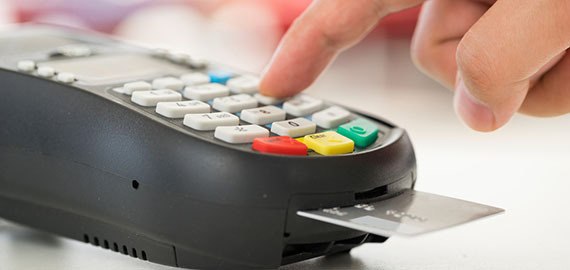
Copyright: alice-photo via Shutterstock.com
The news has been abuzz with the new smartchips that are being rolled out for credit card users across the United States. They have caused a major disruption to how Americans interact with their old trusty pieces of plastic. Netflix, the online video streaming service, has even gone so far as to say that these new chips were in part to blame for their poor fiscal performance last quarter -- causing slower than expected subscriber growth. For all this ruckus surrounding them, one question that sits on the minds of many is: "are these new cards any good?"
Outside of the headaches it brought along with its migration, EMV brings many advancements and benefits to U.S. consumers. Despite the positive traits that smartchips bring with them, many individuals are unaware of them. According to a recent survey conducted by Fiserv, a global financial services technology company, 29% of people have no idea what the benefits of EMV are -- 8% confuse EMV cards with prepaid debit cards. What readers should know is that the benefits of EMV to consumers fall largely into two categories, which are explained below.
- Greater Global Acceptance. EMV is not the new kid on the block. While the technology may be new to the United States, it is old news to the remainder of the world. In the United Kingdom, EMV has been the standard for close to a decade. Even North Korea has beaten the U.S. to the punch, when it came to putting smartchips on credit cards. Lagging behind the rest of the world carried negative impacts for U.S. travelers, who hoped to use their credit and debit cards abroad. In the past, without these chips, it would be impossible to pay in certain locations throughout Europe and Asia, forcing tourists and travellers to rely solely on cash transactions.
Despite the U.S. moving forward with EMV, some U.S. consumers may still run into trouble abroad, due to the differences between chip and pin and chip and signature EMV cards. The United States has moved to adopt the chip and signature variant of EMV technology -- a slightly less popular and less secure feature. In places around the world, where chip & pin is the standard, using U.S. EMV cards may still create issues at unmanned terminals, such as automated ticketing stations. For example, according to research by ValuePenguin, places like France, Ireland and the U.K. are predominantly pin-based.
Greater Security. EMV credit cards are much more difficult to counterfeit, and have less potential vulnerabilities than the old magnetic strip cards. The improved security in EMV cards has to do with how your personal data is stored on the cards. With magnetic strips, the card information was static. Therefore, once the information of the card was grabbed - such as through the use of a skimming device - a fraudster could easily create a duplicate copy of the magnetic strip/card to use as his own. With smartchips, the process is a lot more complicated. EMV chips are small computers on your card, which encrypt and generate data on the fly, with every transaction. Since the data is constantly in flux and changing, it becomes exponentially more difficult to create an exact copy of a credit card. It is estimated that in 2014,3 billion was lost due to counterfeit card payments. This number certainly hurt issuers and businesses a lot more than the average consumer since, after all, most consumers are protected against their cards being used fraudulently. Where people will feel the difference is on the smaller, day-to-day dealings. Every time you fall victim to credit card fraud, a new card and number must be issued. This can create hassles for individuals who had auto-pay features set up with their previous credit card for various subscription and billing services. Going back and updating all the outdated card information can be quite time-consuming.
Most Consumers Still Don't Have an EMV Card
Banks are still in the process of rolling out updated cards, and most consumers are yet to receive theirs. According to the same Fiserv study mentioned earlier, approximately 38% of credit card consumers received an EMV card by now. This represents a substantial year-over-year growth. When this survey was conducted in 2014, just 13% of respondents had an EMV card.
If you still have not received a chip-enabled credit card, you can try calling your issuer. And requesting one Some banks will be reluctant to issue new cards, unless their customers explicitly submit a request. Keep in mind, however, that if a new card is issued with a new number, you will have to go through and update your auto-payments - hopefully for the last time ever. Just don't forget to do the same with Netflix - their next fiscal quarter depends on it.
Support HuffPost
Our 2024 Coverage Needs You
Your Loyalty Means The World To Us
At HuffPost, we believe that everyone needs high-quality journalism, but we understand that not everyone can afford to pay for expensive news subscriptions. That is why we are committed to providing deeply reported, carefully fact-checked news that is freely accessible to everyone.
Whether you come to HuffPost for updates on the 2024 presidential race, hard-hitting investigations into critical issues facing our country today, or trending stories that make you laugh, we appreciate you. The truth is, news costs money to produce, and we are proud that we have never put our stories behind an expensive paywall.
Would you join us to help keep our stories free for all? Your contribution of as little as $2 will go a long way.
Can't afford to donate? Support HuffPost by creating a free account and log in while you read.
As Americans head to the polls in 2024, the very future of our country is at stake. At HuffPost, we believe that a free press is critical to creating well-informed voters. That's why our journalism is free for everyone, even though other newsrooms retreat behind expensive paywalls.
Our journalists will continue to cover the twists and turns during this historic presidential election. With your help, we'll bring you hard-hitting investigations, well-researched analysis and timely takes you can't find elsewhere. Reporting in this current political climate is a responsibility we do not take lightly, and we thank you for your support.
Contribute as little as $2 to keep our news free for all.
Can't afford to donate? Support HuffPost by creating a free account and log in while you read.
Dear HuffPost Reader
Thank you for your past contribution to HuffPost. We are sincerely grateful for readers like you who help us ensure that we can keep our journalism free for everyone.
The stakes are high this year, and our 2024 coverage could use continued support. Would you consider becoming a regular HuffPost contributor?
Dear HuffPost Reader
Thank you for your past contribution to HuffPost. We are sincerely grateful for readers like you who help us ensure that we can keep our journalism free for everyone.
The stakes are high this year, and our 2024 coverage could use continued support. If circumstances have changed since you last contributed, we hope you’ll consider contributing to HuffPost once more.
Already contributed? Log in to hide these messages.

